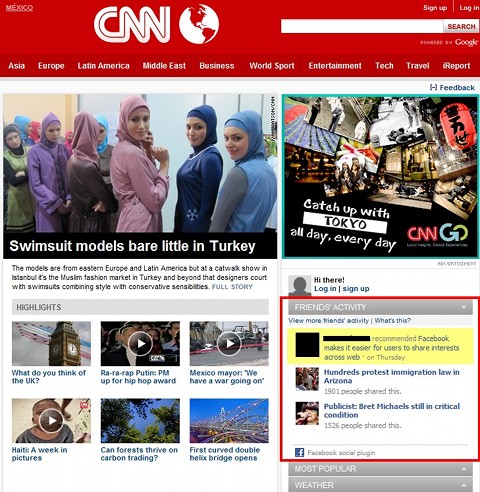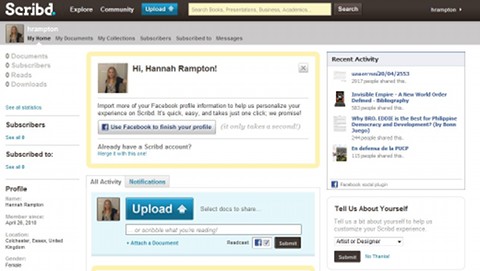Facebook will never be the same again. New changes to its interface mean that users will now have powerful new ways to share interests across the web.
Strategically, the changes have put the social network in competition with Google, which is also ‘personalising search’ based on interests and preferences.
And I think Facebook has the advantage.
Facebook’s new platform was designed to “put people in the centre of the web”. The concept behind the change is that, if you mapped out all the connections between people and their interests, it would form a graph that connects everyone together.
Facebook has focused on mapping out the social side that concerns you and your relationships, with other sites and services mapping out your interests. To target these two goals together, Facebook has released three new components: Social Plug-ins, The Open Graph Protocol and the Graph API.
So what changes have Facebook made and how do they affect you?
If you’re a Facebook user, you’ll already be familiar with the ‘Like’ feature. When you update your status, your connections are given two options. They can either comment on your activity or they can show an interest in your update by liking it.
(Did you know that Facebook has found the average user clicks ‘Like’ on nine pieces of content each month?)

With the advent of Facebook’s new social platform you can now expect to see ‘Like’ – or in some cases ‘Recommend’ – buttons appearing on popular websites. This feature will enable you to interact with external sites and your actions will be shared with your friends on Facebook.
Also, when you visit an external site that supports the feature, you will be able to see your friends’ activity too. You don’t have to connect with Facebook if you are already logged in – the information is automatically displayed.
If none of your friends has interacted with the activity, then you will see the following:

If your friends have interacted, then their information will be displayed:
.jpg)
As mentioned above, certain items that you interact with are then published in your Activity Feed.

Another benefit of this integration is that ‘recommended activity’ feeds can now be tailored to incorporate your friends’ activity rather than the public as a whole. If no friends have interacted with the site, then the feed will automatically display your normal ‘public’ activity.
In this example, a friend of mine had interacted with CNN.com, so his recommendation is displayed. The rest of the recommendations are from general Facebook users.

At present, most of the websites that have already updated their website to support Facebook’s new platform are USA-based, but it is early days yet. Any kind of website can support Facebook’s social graphing, including retail, blogs, news, travel and others.
So far, some of the included sites are:
• IMDB (Internet Movie Database)
• Levi’s
• Sephora
• Scribd
• Trip Advisor
• TypePad
• Sky News
There is already a large number of supporting websites, including nearly all major USA news sites. A full list of websites that are involved with Facebook social graphing can be found here.
Another innovation you may experience is a simplified registration process. I visited Scribd to see how it has incorporated the Facebook social plug-in into its site – with one click I had gone from not being registered at all, to this:

With one more click, I could enable Scribd to ‘Use Facebook to finish my profile’, bringing my whole registration journey down to 2 clicks and less than 20 seconds. It could not be simpler!
In light of all this information sharing, ‘privacy’ will certainly crop up as a concern. How is our data being handled now that Facebook wants to connect with the whole of the web?
We have been firmly reassured that none of our personal Facebook data is shared with websites that use the new features. Social plug-ins pull information directly from Facebook and the site has no access to the data being displayed to you. The new features will only be visible to you on these websites if you are logged into Facebook.
All users are able to opt out of the new features but, either way, I would strongly recommend that you review your privacy settings. It’s worth remembering that Facebook pulls in your profile photo and displays this next to your interaction online, so it is more crucial than ever before that you use an appropriate picture.
You can change your settings under Account > Privacy Settings > Applications and Websites. Mashable also has an excellent, illustrated guide to disabling Facebook’s ‘Instant Personalisation’ that you might find useful.
My take on the Facebook changes
I am really excited about these changes. I think many websites will join in with Facebook’s open graph and it will not be long before the familiar ‘Like’ buttons are seen everywhere. Facebook integration will be great for quick registrations, and this will make sharing a lot easier all round. I do, however, hope that websites will adopt two streams of recommendations – one for the public and one for friends. After all – with the greatest respect to all of them – I don’t always want to follow my friends’ recommendations!
